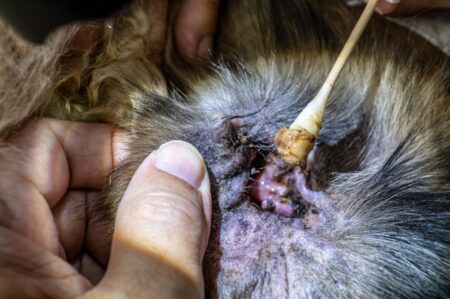Dog Ear Mites vs. Ear Wax: All You Need To Know
Ear mites and ear wax are two very common ear issues that can affect your dog’s ears. Knowing the differences between them and how to identify and treat them can help keep your pup’s ears healthy and free from discomfort. In this article, we’ll look at the differences between dog ear mites and ear wax, how you can identify them, and provide helpful tips on how to treat them. We’ll also provide resources for further reading.
Dog Ear Mites vs. Ear Wax: All You Need To Know
Dog ear mites are tiny parasites that live in the ear canal and feed off the wax and oils produced by the canine’s ear. They can cause serious irritation and inflammation of the ear, leading to redness, itching, and foul odors. Ear mites are contagious and can be passed from dog to dog through contact. Treatment usually involves using a topical insecticide to kill the mites as well as cleaning the ear canal and treating any secondary bacterial or yeast infections.
Ear wax is a natural secretion produced by canine ears to protect and lubricate the ear canal. While ear wax can provide a healthy environment for beneficial bacteria, excess or abnormal amounts of wax can signal underlying medical conditions or be a sign of infection. Overly dark, excessive, or foul-smelling wax can be treated by gently cleaning the ear with a medicated ointment or solution and removing the excess wax.
What Are Dog Ear Mites?
Dog ear mites are tiny parasites that live in the warm, moist environment of a dog’s ear canal. These mites feed on wax and oil secretions in a dog’s ear, and they can cause irritation and inflammation. Symptoms of ear mites in dogs include excessive scratching or pawing at the ears, reddened or dirty ears, head shaking, an offensive odor coming from the ears, and scabbing or crusting of the skin in the ear canal. If left untreated, ear mites can cause a bacterial or yeast infection. Treatment for dog ear mites usually involves an ear cleaning and the application of a topical ointment containing an insecticide.
Why Does Your Dog Get Ear Mites?
Ear mites are parasites that travel from one dog to another, usually through close contact. They also can be acquired by contact with an infected environment such as bedding, grooming items, and other surfaces where a dog may lay or rub its ears. They can also be passed from a dog to a cat, and vice versa. Sources of ear mites can include other animals, soil, and even humans.
Symptoms of Ear Mites
- Itching – Itching is the primary symptom of ear mites and it is usually severe. There may be an intense urge to scratch and rub the affected area.
- Brown discharge – A brownish-black wax-like discharge with a foul odor may be present in the affected ear.
- Hair loss – In some cases, hair loss around the affected ear may occur due to severe itching.
- Head shaking – Dogs with ear mites will often vigorously shake their heads, especially when they are trying to scratch or scratch at the affected ear.
- Redness/irritation – Redness and irritation around the ear a common symptoms of ear mites.
- Swelling – Swelling or inflammation around the ear may occur due to the presence of mites.
How to Diagnose Ear Mites in Dogs
- Begin by inspecting your dog’s ears closely. Look for reddened skin, dark-colored wax, and discharge. Also, check for unusual odors and check for head shaking or scratching.
- Perform gentle cleaning of the ears with a solution recommended by your veterinarian to remove built-up wax and debris that may be harboring the mites.
- Take a swab of the discharge and/or wax from the ears and send it to a laboratory for analysis. This will confirm the presence of ear mites.
SEE ALSO: Dog Bites Home Depot Customer: What To Do
Ear Mite Treatment for Dogs
Ear mites are small, eight-legged parasites that colonize the ears of dogs. They cause an intense itching sensation, often accompanied by head shaking and ear scratching. Ear mite treatment for dogs includes medications designed to kill mites and their eggs and to provide relief from the itching. Treating the entire household is important to prevent reinfection.
- Medication – Otodectes cynotis, the type of mite that most commonly affects dogs, is best treated with a topical medication designed to kill the mites as well as their eggs. Ivermectin and selamectin are two products that are regularly used in ear mite treatment for dogs and are available in ear mite drops and spot-on treatments. These products are applied directly to the affected area and can be used in puppies as young as 6 weeks old.
- Cleaning – Before applying the medication, clean the affected area by flushing the ear canal with a solution designed specifically for cleaning pet ears. This helps remove dirt, debris, and wax to allow the medication to penetrate more effectively. After flushing the ears, use a piece of gauze or cotton swab to gently remove any remaining residue.
- Follow-up Treatment – The medication prescribed by your veterinarian is generally effective in treating ear mites in dogs, but the entire household should be treated to prevent reinfection. Discuss with your veterinarian the best way to clean the bedding, furniture, and grooming supplies of the infected pet to prevent the spread of mites.
- Medicated Baths – Occasionally, ear mites cause significant irritation and itching that can be relieved by medicated baths. Medicated shampoos sold for the treatment of ear mites contain ingredients such as sulfur or pyrethrin to kill mites and provide relief from itching. These should only be used under the supervision of a veterinarian and should not be used more than once a week.
Home Remedies for Ear Mites in Dogs
- Clean your dog’s ears regularly – Use a cotton ball dampened with a mixture of equal parts white vinegar and warm water to clean your dog’s ears once or twice a week. Be sure to only clean the outer parts of their ear, as ear drops or cleaners designed for cleaning the inner ears can damage their hearing.
- Coconut oil – Applying a few drops of coconut oil to your dog’s ears has been known to help kill the ear mites that might be causing problems. Put a few drops of the oil in their ears each day for at least a week.
- Apple cider vinegar – Mix two parts of apple cider vinegar and one part of warm water together and use a cotton ball to clean your dog’s ears. This remedy is said to help reduce any swelling caused by the ear mites while killing them off as well.
How Do You Prevent Ear Mites in Dogs?
To prevent ear mites in dogs, keep your pup’s ears clean and dry. Use a cotton swab or mild cleanser to clean their ears regularly, usually once or twice a week. Make sure to dry their ears thoroughly after baths or swims and keep their ears free of excess wax, dirt, and debris. Additionally, maintain your pup’s general health with good nutrition, regular grooming, and flea and tick prevention. Talk to your veterinarian for more specific instructions.
What is Earwax?
Earwax, also known as cerumen, is a yellowish, waxy substance produced in the ear canal of humans and other mammals. It is normally produced to wash away dirt and debris, slow down the growth of bacteria, and keep the ear canal lubricated.
Normal Dog Ear Wax: What Does it Look Like?
Normal dog ear wax is typically a light yellow or light brown that looks like a thick paste. It should be odorless and not too sticky. If your dog’s ear wax is darker, black, or has an unpleasant smell, this may be a sign of an infection. In some cases, the wax may have a waxy texture or be dry and crumbly.
Treatment Options for Earwax
- Ear Irrigation: Ear irrigation is a safe and effective way to remove wax buildup from the ear canal. It involves using a pressurized stream of water to flush out the wax.
- Manual Removal: Some earwax can be removed manually using a cotton swab, fingers, or other tools such as a curette. However, this is not recommended and can cause damage to the ear or push the wax further down the ear canal.
- Earwax Removal Drops: Over-the-counter solutions and gels such as hydrogen peroxide, carbamide, or sodium bicarbonate can help soften and loosen earwax.
- Ear Candling: This is an ancient practice involving placing a long hollow tube, often made of fabric or beeswax, against the ear and lighting the opposite end. This is thought to draw out the wax. However, there is no scientific evidence to back up this claim and it can be dangerous if done incorrectly.
- Surgery: The most extreme form of earwax removal is a minor surgical procedure called a myringotomy, which is cutting a small hole in the ear to help remove impacted wax.
Safety Tips for Removing Ear Wax From Dogs
- Never attempt to remove ear wax from your dog’s ear canal yourself. It’s best to leave this task to a veterinarian or professional groomer.
- Before attempting to remove ear wax from a dog’s ears, always inspect the ears for signs of infection or another health issue, such as redness, tenderness, or swelling. If you notice any of these symptoms, get the dog to a veterinarian right away.
- If a professional groomer or veterinarian recommends ear cleaners or cleaners, make sure to use products specifically designed for dogs.
- NEVER use hot water, cotton swabs, or human ear drops to remove ear wax from your dog’s ears.
- Moisten the ears and massage them gently to help loosen the wax before cleansing.
- Pay close attention to the areas around the ear canal, as wax accumulates there as well.
- Keep a close eye on your dog’s ears and clean them when necessary to prevent wax build-up.
SEE ALSO: Dog Commands in German And Their Meaning In English
FAQs
Q. What should dog ear wax look like?
A. Dog ear wax should be light to dark tan in color and have a soft, waxy consistency.
Q. How do you tell if your dog has ear mites or just dirty ears?
A. To tell if your dog has ear mites or just dirty ears, look for signs of inflammation, redness, and scratching in the ears. Also look for black or brown debris in the ears, which can indicate the presence of ear mites.
Q. What kills ear mites in dogs?
A. Ear mites in dogs can be treated with an insecticidal ear drop, such as Milbemite or Mitaban. These products are applied directly into the ear, and they kill existing mites after a few days of treatment.
Q. How do you know if your dog has ear mites or an infection?
A. You may know your dog has ear mites or an infection if they are shaking their head excessively, scratching their ears, and/or have a foul odor coming from their ears. Your veterinarian can also perform an ear swab to confirm the presence of ear mites or an infection.
Q. Can humans get ear mites from dogs?
A. Yes, humans can get ear mites from dogs. Ear mites are extremely contagious and can spread between animals, including humans, through direct contact.
Conclusion
In conclusion, it is important to understand the differences between ear mites and ear wax because they can cause a variety of issues in your pet’s ears. In order to keep your pet healthy, it is important to regularly check your pet’s ears for signs of any of these problems and take any necessary action. Doing so will ensure that your pet’s ears remain healthy and free of infection or harm. If you find that your pet has either ear mites or ear wax, you should consult a veterinarian immediately so that they can recommend the best course of action for your pet.

